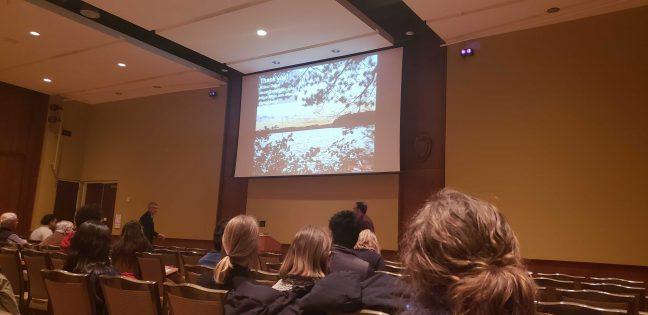A University of Wisconsin climate scientist said climate change affects Wisconsin forests, during a lecture for the Nelson Institute Center for Climatic Research Symposium on Thursday.
Ankur Desai said the biosphere — or the region of Earth encompassing parts of the atmosphere, Earth’s surface and oceans that contain living organisms — breathes, in the sense that it cycles carbon and energy, and has varied climatic patterns.
Desai said releasing CO2 into the atmosphere by burning fossil fuels causes a reaction from the biosphere. The ocean and the biosphere roughly balance fossil fuel emissions, he said, by dissolving CO2 into the ocean or the soil.
While CO2 levels in the land and ocean have steadily increased over the years, CO2 growth in the atmosphere rises in erratic peaks and troughs, generally each year with a peak higher than the last.
“The land biosphere, the forest, the wetland, the lakes … all of these things are driving how fast atmospheric CO2 increases year to year,” Desai said.
Desai called the measurement of these land biome carbon levels the land flux. He said the models he and other climate scientists have run for the future predict increases in land flux — which, if severe enough, he said could turn lush forests arid or cause more wildfires like the recent Australian bushfires.
Desai conducts research in northern Wisconsin. His team makes measurements with a television tower on the hour. In the forest, his team found highly variable patterns because of the nature of the seasonal forest biome and weather, but he also found a steady increase in CO2 levels over the years since they’ve started data collection. He said CO2 rose 360 parts per million to 440 over the course of his data collection so far, which is a significant increase.
Desai’s team also studies wind patterns — which he calls measuring the “breath of the biosphere.” When winds move over land, plants and other geographic features absorb some of the CO2 from these winds. That means, he said, his team can construct towers on land to measure the CO2 signature from the gusts.
“If you have gusty winds… then those turbulent gusts are going to move over land,” Desai said. “Every time they get close to a leaf, they’re going to lose some CO2.”
Forests take up a lot of carbon, Desai said, and the extent to which depends on a lot of factors, including the age of the forest. Old growth forests can take up a lot of carbon, sparser forests take up less. During the 2012 drought, the forest they studied took up much less carbon, so temperature and climate also have huge impacts, he said.
Desai also collected data across landscapes including wetlands and lakes. What he found were lots of different ecological, climatic and biochemical processes that affect the biosphere’s carbon composition in Wisconsin alone.
Desai said this research can answer questions around where we should be planting trees to restore forests, or how best to implement sustainable agricultural practices.


